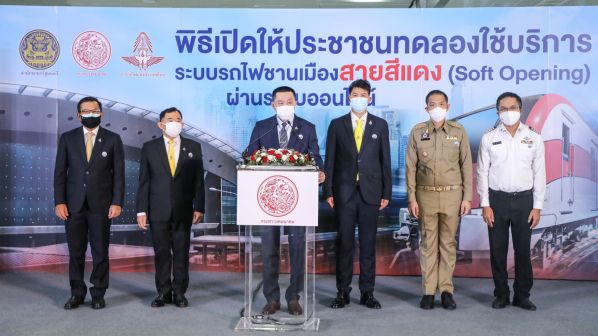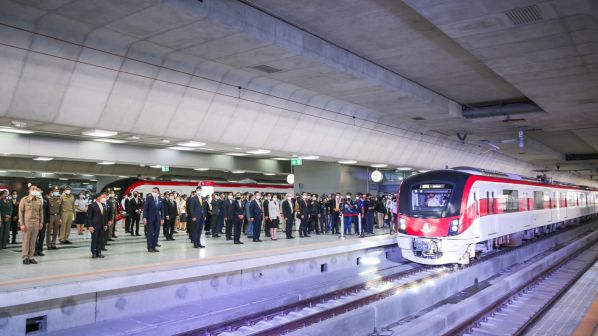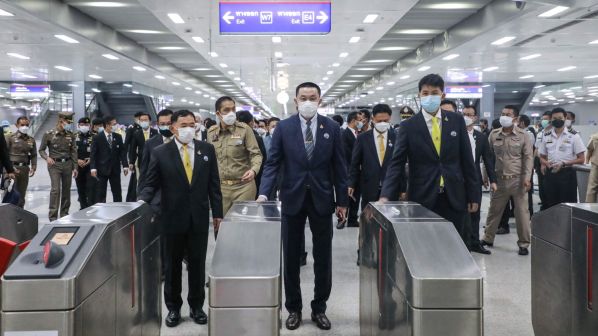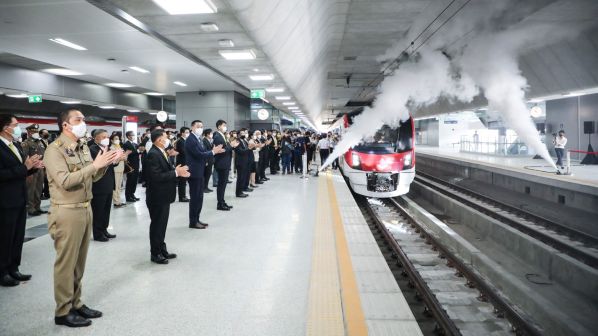TRIAL operation has commenced on the Red Line commuter service in Bangkok, which connects with the newly-constructed Bang Sue central station that will become the country’s major rail hub following the completion of Thailand’s high-speed rail network.
The 26km elevated metre-gauge line runs north-south from Bang Sue to Rangsit, with 10 stations including a connection to Don Mueang International Airport. There is also a 15km elevated branch to the west from Bang Sue to Taling Chan, with three stations. The line will provide a 25-minute journey time from Bang Sue to Rangsit and a 15-minute journey time from Bang Sue to Taling Chan. Passengers can travel for free during the trial period until the full opening in November, after which journeys will cost Baht 42 ($US 1.27).
Services will operate every 30 minutes between 06.00 and 20.00, increasing to every 15 minutes during peak periods for a total of 78 journeys each day with capacity for 1710 passengers on each train, although this will initially be capped at 50% due to the Covid-19 pandemic.

The first service was launched by prime minister, General Prayut Chan-o-cha, on August 2 at a ceremony attended by minister of transport, Mr Saksiam Chidchob, the governor of State Railway of Thailand (SRT), Mr Nirut Maneephan, the Japanese ambassador to Thailand, Mr Nashida Kazuya, and the chief representative of the Japan International Cooperation Agency (Jica) in Thailand, Mr Morita Takahiro.
Jica provided a Yen 268.81bn ($US 2.46bn) loan for the construction of the Bang Sue - Rangsit section, as well as the rolling stock and electrical equipment for the entire line. Jica previously supported the construction of Bangkok’s Blue Line, which opened in 2004, and the Purple Line, which opened in 2016.
SRT awarded a Baht 32.4bn four-year electrical and mechanical turnkey contract to a Japanese consortium of Mitsubishi Heavy Industries, Hitachi, and Sumitomo in April 2017. The contract included the design and installation of track, overhead electrification, signalling, and telecommunications on the elevated extensions as well as the supply of EMUs.

Nippon Signal was awarded a signalling contract by Mitsubishi Heavy Industries in January 2018 to install a computer-based interlocking, automatic train supervision system (ATS), automatic train protection (ATP) and a train detection system, including ETCS Level 1. Thales was sub-contracted by Nippon Signal to install the ETCS Level 1 on the rolling stock and the line.
Hitachi shipped the first of 25 EMUs for the project from its Kasado facility in Japan in September 2019.
A skywalk will be built to connect with the proposed Pink Line and Chulabhorn Hospital at Lak Si Station. Other forms of transport such as bus routes have been adjusted to better connect with the Red Line.
Bang Sue: Thailand’ new rail hub
Bang Sue central station will replace Hua Lamphong station as the major hub for long-distance and regional services in Thailand. Construction of the new station began in 2013 and was completed earlier this year. The station, which is currently being used as a vaccination centre, is due to officially open with the start of commercial operation on the Red Line in November.

The station has three floors. The 87,200m2 ground floor concourse provides access to the Blue Line, as well as a ticketing area, shops, food courts, offices and a waiting area. The 58,900m2 second floor provides eight platforms for long-distance services and four platforms for the Red Line, while the 58,900m2 third floor will has two platforms for the airport rail service, six platforms for the future north and northeast high-speed services, and four platforms for southern high-speed trains. Construction of the first phase of the Baht 179.41bn, 253km Bangkok - Laos high-speed line is currently underway.
A 20,700m2 mezzanine floor will have shops and a control room. The 72,500m2 basement has 1700 parking spaces, including 19 spaces for people with limited mobility. The station also features an 18,630m2 royal monument, which includes a 14,000m2 pond as a tribute to the king. A 6m-wide clock built by Electric Time Company, United States, has been installed 21m above ground level at the front of the station.
For detailed data on commuter rail projects from around the world, subscribe to IRJ Pro.

